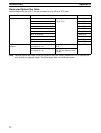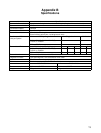
Glossary
76
An area in the PC’s memory that is designed to hold a specific type of data,
e.g., the LR area is designed for to hold common data in a PC Link System.
A automation concept in which control of each portion of an automated sys-
tem is located near the devices actually being control, i.e., control is decen-
tralized and ‘distributed’ over the system. Distributed control is a concept ba-
sic to PC Systems.
Electrical ‘static’ that can disturb electronic communications. The ‘snow’ that
can appear on a TV screen is an example of the effects of electrical noise.
A Backplane used to create an Expansion I/O Rack.
Part of a building-block PC, an Expansion I/O Rack is connected to either a
CPU Rack or Slave Rack to increase the number of slots available for mount-
ing Units.
The number of inputs and outputs that a PC is able to handle. This number
ranges from around one-hundred for smaller PCs to two-thousand for the
largest ones.
A Unit mounted to the CPU Rack in certain PCs to monitor and control I/O
points on Expansion I/O Units.
The devices to which terminals on I/O Units, Special I/O Units, or Intelligent
I/O Units are connected. I/O devices may be either part of the Control Sys-
tem, if they function to help control other devices, or they may be part of the
controlled system.
A Unit mounted to an Expansion I/O Rack in certain PCs to interface the Ex-
pansion I/O Rack to the CPU Rack.
The place at which an input signal enters the PC System or an output signal
leaves the PC System. In physical terms, an I/O point corresponds to termi-
nals or connector pins on a Unit; in terms of programming, an I/O point corre-
sponds to an I/O bit in the IR area.
The most basic type of Unit mounted to a backplane to create a Rack. I/O
Units include Input Units and Output Units, each of which is available in a
range of specifications. I/O Units do not include Special I/O Units, Link Units,
etc.
An interface is the conceptual boundary between systems or devices and
usually involves changes in the way the communicated data is represented.
Interface devices such a NSBs in Net Link Systems perform operations such
as changing the coding, format, or speed of the data.
A Unit used to connect communications lines, either to branch the lines or to
convert between different types of cable. There are two types of Link
Adapter: Branching Link Adapters and Converting Link Adapters.
A hardware or software connection formed between two Units. “Link” can
refer either to a part of the physical connection between two Units (e.g., opti-
cal links in Wired Remote I/O Systems) or a software connection created to
data existing at another location (Network Data Links).
data area
distributed control
electrical noise
Expansion I/O Backplane
Expansion I/O Rack
I/O capacity
I/O Control Unit
I/O devices
I/O Interface Unit
I/O point
I/O Unit
interface
Link Adapter
link


















